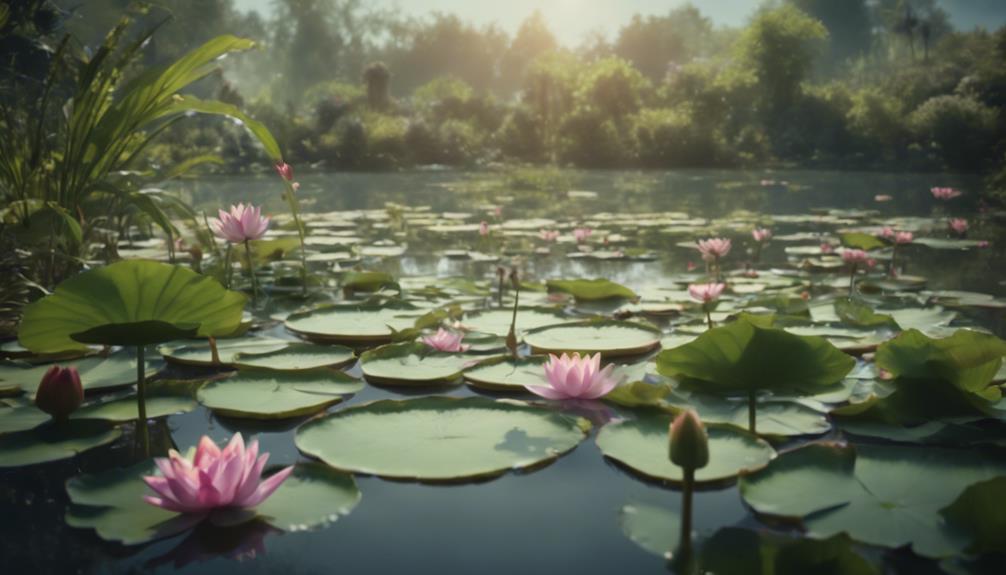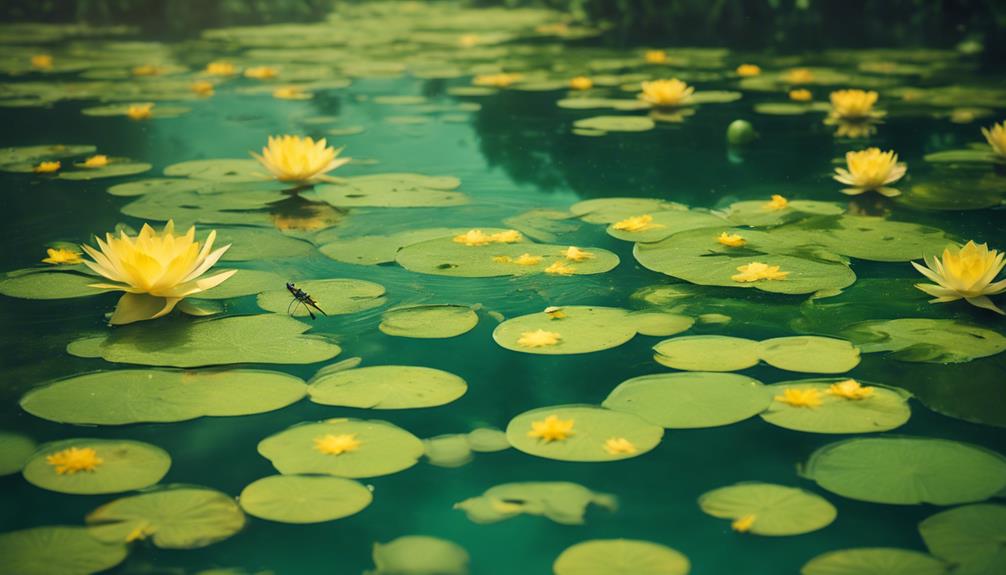By incorporating native aquatic plants into your pond, you'll create a thriving ecosystem that attracts a diverse range of wildlife. For birds, choose plants like soft-stem bulrush, pickerelweed, and American lotus that provide shelter, food, and breeding grounds. For insects, opt for plants with nectar-rich flowers like water lilies, cattails, and pickerelweed. Submerged plants like hornwort, cabomba, and anacharis provide shelter for fish, while emergent plants like cardinal flower and blueflag iris offer perches for dragonflies. Discover the 7 best aquatic plants to attract pond wildlife and reveal the secrets to a balanced ecosystem that supports local biodiversity.
Table of Contents
Key Takeaways
- Native aquatic plants provide food, shelter, and breeding grounds for local wildlife, co-evolving with species to create a thriving ecosystem.
- Bird-friendly plants like soft-stem bulrush and American lotus attract a diverse range of bird species, offering shelter, food, and nesting sites.
- Insect-attracting plants like water lilies and cattails produce nectar-rich flowers, supporting pollinators and contributing to the pond's biodiversity.
- Submerged plants like hornwort and cabomba provide shelter and protection for fish, improving their survival rates and overall well-being.
- Emergent plants like pickerelweed and cardinal flower offer dragonflies perches, habitat, and shelter, supporting their entire lifecycle.
Native Plants for Wildlife Habitats
What makes native aquatic plants ideal for creating thriving wildlife habitats in and around your pond?
For starters, native pond plants have co-evolved with local wildlife, providing a natural source of food, shelter, and breeding grounds. By incorporating native plants into your wildlife pond, you're mimicking the natural environment, allowing native species to flourish.
These plants have adapted to your region's unique water conditions, ensuring they'll thrive with minimal maintenance.
Native water plants also play a vital role in maintaining water quality, absorbing excess nutrients and reducing algae growth. This, in turn, provides a healthy environment for aquatic life to thrive.
By choosing native plants, you're creating a haven for local wildlife, from fish and amphibians to birds and insects. They'll provide shelter, protection, and a source of sustenance, attracting a diverse range of species to your pond.
Water's Edge Plants for Birds
As you plan your pond's water's edge, you'll want to select native plants that cater to the needs of visiting birds.
By creating a shoreline habitat that incorporates bird-friendly plant choices, you'll attract a variety of species and provide them with essential resources.
Native Plant Selection
Select native water's edge plants that provide shelter, food, and breeding grounds for birds, such as soft-stem bulrush, pickerelweed, and American lotus, which thrive in shallow water and muddy shorelines.
These plants are ideal for creating a welcoming habitat around your pond, as they're naturally adapted to the local climate and soil conditions.
By choosing native species, you'll attract a diverse range of bird species that are specifically adapted to your region.
For instance, native plants like cattails and sedges provide perfect nesting sites for birds like the American coot and marsh wren.
When selecting native plants, consider the specific conditions around your pond.
Look for plants that thrive in similar environments, such as wet meadows or shallow water.
You can also consult with local nurseries or conservation organizations to find native plant species that are well-suited to your area.
Shoreline Habitat Creation
By thoughtfully designing your pond's shoreline with a mix of emergent and submerged plants, you can create a dynamic habitat that caters to the specific needs of birds, from foraging and roosting to breeding and nesting.
A well-planned shoreline habitat can become a hub of activity, attracting a diverse range of bird species.
When planting around your marginal pond, prioritize native species that thrive in wet conditions. These plants will help stabilize the shoreline, reducing erosion and creating a natural buffer zone.
As you plant, consider the varying heights and growth habits of different species to guarantee a layered, textured landscape. This will provide birds with a range of hiding spots, perches, and foraging opportunities.
By incorporating a mix of plants with different bloom times, you'll create a constant source of food and shelter for birds throughout the year.
With careful planning, your shoreline habitat can become a haven for local bird populations, fostering a sense of community and connection to the natural world.
Bird-Friendly Plant Choices
When selecting species for your water's edge, choose aquatic plants that provide specific benefits to birds, such as food, shelter, and nesting sites.
Plants with dense foliage, like Water Lilies, offer shelter and protection from predators, while others with showy flowers, like Flag Iris, attract birds with nectar-rich blooms. Purple Loosestrife, with its tall spikes of purple flowers, is a favorite of hummingbirds and butterflies.
Native floating plants, such as Water Hyacinth or Duckweed, provide a crucial food source for migratory birds, like ducks and geese. These plants also help to stabilize the water's edge, creating a safe haven for birds to rest and forage.
When selecting plants, consider the specific needs of the bird species you want to attract. By choosing a diverse range of bird-friendly plants, you'll create a welcoming habitat that supports the local avifauna. By doing so, you'll not only attract a variety of bird species but also contribute to the overall health and biodiversity of your pond ecosystem.
Aquatic Plants for Insect Attraction

Insect pollinators, such as bees and butterflies, are drawn to aquatic plants that produce nectar-rich flowers, like water lilies and cattails, which provide a vital source of energy for their survival.
As you create a pond habitat, you'll want to include plants that attract these beneficial insects.
Water Lilies (Nymphaea spp.): Their fragrant flowers bloom in shades of white, yellow, and pink, providing a sweet treat for pollinators.
Cattails (Typha latifolia): The brown, cylindrical flowers of cattails produce a rich source of nectar, making them a favorite among bees and butterflies.
Pickerelweed (Pontederia cordata): This aquatic plant produces purple flowers that are rich in nectar, attracting a variety of pollinators to your pond.
American Lotus (Nelumbo lutea): The large, fragrant flowers of the American lotus are a popular choice for attracting pollinators to your pond.
Submerged Plants for Fish Shelter
As you design a pond habitat that attracts insect pollinators, don't forget to incorporate submerged plants that provide shelter and protection for fish, which are equally essential to the ecosystem's balance.
These plants create a safe haven for fish to hide from predators, improving their survival rates and overall well-being. Some excellent options include Hornwort, Cabomba, and Anacharis, which grow quickly and form dense thickets that provide hiding places.
Water Wisteria can be trained to grow on a trellis or left to trail, offering shelter for fish as they swim through its flowing stems.
For a low-maintenance option, Java Moss can be attached to rocks or driftwood, creating a habitat for small fish and invertebrates to hide and feed.
By incorporating these submerged plants into your pond design, you'll create a thriving Oxygenating Pond ecosystem that supports a diverse range of aquatic life.
Emergent Plants for Dragonfly Perches

By incorporating emergent plants with sturdy stems and varying heights into your pond design, you create a welcoming habitat for dragonflies to perch, hunt, and thrive. These plants provide the perfect spot for dragonflies to rest, survey their surroundings, and take off to catch prey.
Four excellent emergent plants for attracting dragonflies are:
- Pickerelweed (Pontederia cordata) and Soft Rush (Juncus effusus), which grow 3-4 feet tall and have sturdy stems that can support the weight of these insects.
- Cardinal Flower (Lobelia cardinalis) and Blueflag Iris (Iris versicolor), which grow 2-5 feet tall and have strong stems that can withstand the weight of dragonflies.
- Bulrush (Typha latifolia) and Cattail (Typha angustifolia), ideal for attracting dragonflies to a pond as they often perch on these plants to hunt, mate, and bask in the sun.
- Arrowhead (Sagittaria latifolia) and Swamp Milkweed (Asclepias incarnata), which provide sheltered perches for dragonflies, protecting them from strong winds and predators.
Bog Plants for Amphibian Homes
You can create a haven for amphibians by incorporating bog plants into your pond ecosystem, as these plants provide shelter, breeding grounds, and a diverse range of habitats that attract amphibians and support their entire lifecycle.
Bog plants like Gunnera manicata and Baldellia ranunculoides thrive in boggy conditions, offering a habitat for species like the European common frog and the common toad.
These plants help maintain water quality by absorbing excess nutrients, which in turn supports the health and well-being of amphibians and other aquatic species.
The dense foliage of bog plants provides a safe haven for amphibians to hide from predators, while their flowers attract insects that serve as a food source.
By incorporating bog plants into your pond ecosystem, you can create a thriving habitat that supports the entire lifecycle of amphibians, from breeding to metamorphosis.
With bog plants, you can attract a diverse range of amphibians and support the delicate balance of your pond's ecosystem.
Floating Plants for Wildlife Food

While bog plants provide shelter and habitat for amphibians, floating plants take on a different yet equally important role, serving as a vital food source for various wildlife species. As you incorporate floating plants into your pond, you'll create a thriving ecosystem that supports local wildlife.
Four key benefits of floating plants include:
Clearer water: Floating plants like water soldier and frogbit help keep the water clear and free of algae, providing cover for fish and wildlife.
Habitat creation: Water soldier's leaves float on the surface, while its roots hang underneath, providing an ideal habitat for aquatic insects and small fish.
Insect attraction: Frogbit's small white flowers and oval-shaped leaves attract beneficial insects like bees and butterflies.
Native support: Both water soldier and frogbit are native to the UK, making them perfect for creating a natural, balanced ecosystem that supports local wildlife.
Frequently Asked Questions
What Can I Plant Next to a Wildlife Pond?
When selecting plants for your pond's edges, consider native species that thrive near water features. You'll attract wildlife with thoughtful flower choices, such as water lilies, irises, or rushes, which provide habitat and food for local fauna.
What Will My Pond Attract?
As you create a haven, your pond will attract a diverse array of life, including pond predators, water birds, and local species, which will thrive among the aquatic insects that call your pond home.
What Plant to Put Around a Pond?
When choosing plants around your pond, you'll want to think about pond edging, water features, and pond liners for a thriving ecosystem. For bank stabilization, select vegetation with deep roots, like cattails or reeds, to prevent erosion and create a natural habitat.
Can You Put Aquatic Plants in a Pond?
"Oh, you think you can just toss aquatic plants into your pond like it's a salad bar? Please, consider the aquatic depth, pond size, and water quality before selecting plants, or you'll end up with a murky mess!"
Conclusion
As you gaze out at your thriving pond, imagine a delicate web of life unfolding before your eyes.
Like a masterfully woven tapestry, each aquatic plant plays a crucial role in attracting and supporting a diverse array of wildlife.
From birds flitting about the water's edge to fish darting through submerged vegetation, every species finds a home in this harmonious ecosystem.
By incorporating these seven aquatic plants, you've woven a rich fabric of biodiversity that will continue to flourish and fascinate for years to come.

